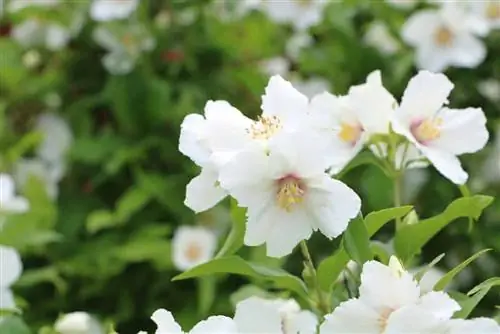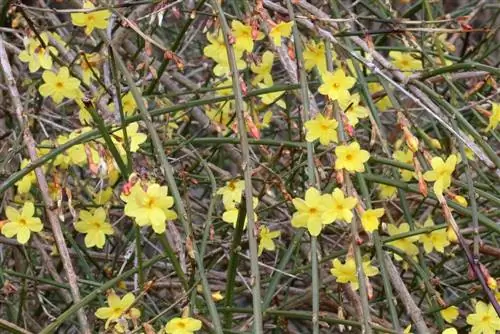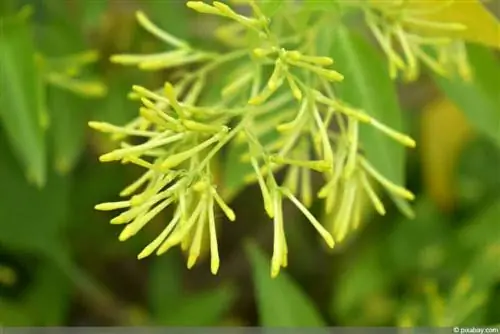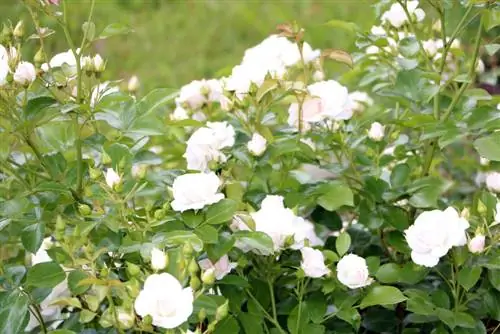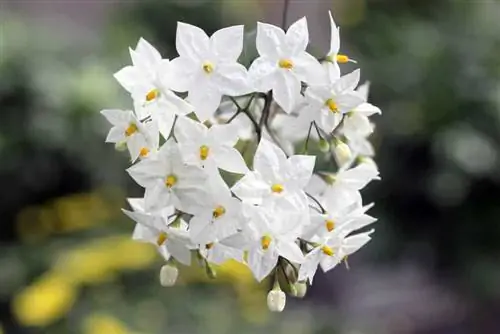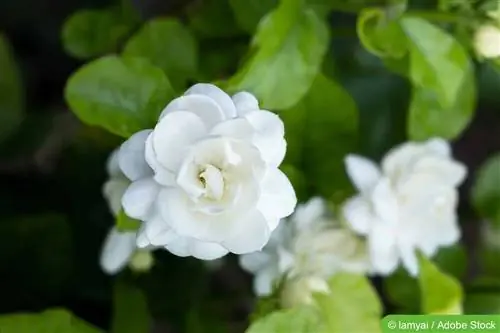- Author admin [email protected].
- Public 2023-12-17 03:39.
- Last modified 2025-06-01 06:48.
The fact that summer jasmine is a member of the nightshade family does not detract from its decorative presence. Regardless of its botanical classification, the enchanting potted plant stages its white floral pattern as a glamorous performance.
The exotic climbing and hanging plant adorns balconies and terraces all summer long, stylishly climbing towards the sky or gracefully dangling its flower-covered shoots. You can easily cope with the somewhat feudal demands on plants, care and wintering with the following tips.
Profile
- Plant family of the nightshade family (Solanaceae)
- Name of the species: Jasmine nightshade (Solanum jasminoides)
- colloquial title: summer jasmine
- woody climbing plant with shoots up to 1 meter long
- native to Brazil, Uruguay and Paraguay
- not hardy
- large inflorescences with up to 50 white flowers
- Flowering period from April to October
- green leaves simple to pointed-oval shaped
- poisonous in all parts
- Common name: potato bush
Summer jasmine is able to wind its way up any conceivable trellis. If no trellis is available, it thrives lying down or is cultivated as a hanging plant.
Location, soil conditions and substrate
Summer jasmine cultivation is not limited to keeping it in containers, although this variant is considered particularly recommended. There is nothing wrong with planting the climbing plant on a sun-drenched house wall during the warm season, as long as a climbing aid is available there. The following conditions should be met in the bed and on the balcony:
- sunny to semi-shady location
- warm and protected from the wind
- nutrient-rich, humus-rich, slightly moist garden soil
- loose, well-drained, without waterlogging
In the planter, it is advisable to use high-quality potting soil enriched with compost, a handful of horn shavings and perlite for permeability.
Plants in the bed
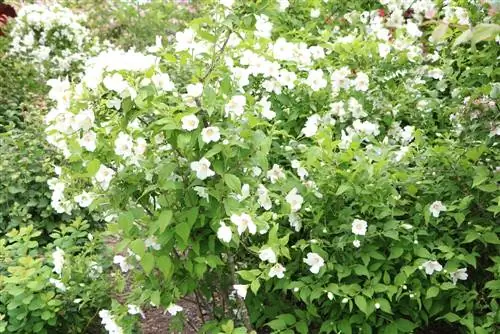
Careful soil preparation creates the best conditions for growth and flowering. Wait until there is no longer a threat of delayed ground frost after the Ice Saints before carrying out the following work. Loosen the soil deeply, as unfavorable compaction often occurs, especially in front of a house wall or a fence. Stones, roots and all weeds are removed and then plenty of compost, horn shavings, horse manure or stable manure are incorporated. How to proceed:
- soak the young plant in the pot with water until no more air bubbles appear
- In the meantime, dig a planting hole with twice the volume of the root ball
- If necessary, create a drainage system on the pit floor made of gravel, grit or pottery shards
- Unpot summer jasmine and plant below the first pair of leaves
After casting, the lower tendrils are attached to the climbing aid. In this way you direct the twining shoots in the desired climbing direction.
Tip:
If you plant summer jasmine in the ground in a pot, this foresight will make moving to winter quarters much easier.
Plants in pots and flower boxes
Planters that have an integrated trellis, an obelisk or a pyramid are ideal for the potato bush. Alternatively, choose a sturdy hanging basket or an innovative hanging basket made of metal. In addition, several floor openings are essential for water drainage. While the pot or flower box is being prepared to accommodate the plant, the still potted root ball is soaked with water.
- spread a drainage system made of perlite, expanded clay or pottery shards over the water drain
- Place a water- and air-permeable fleece over it so that the material is not clogged with soil crumbs
- fill in a layer of substrate, insert the potted summer jasmine and surround it with the remaining soil
- press the potting soil repeatedly so that no cavities form and water well
Make sure you have a watering edge of around 5 centimeters so that wet soil doesn't spill over every time you water.
Useful care tips
A jasmine-flowered nightshade needs your regular attention because its water and nutrient requirements are high. The following tips would like to contribute to optimal care:
- Keep summer jasmine constantly moist without causing waterlogging
- During hot summer periods, water daily in the early morning or late evening if necessary
- Do not use ice-cold tap water, use rain or pond water
- fertilize every 2 weeks from March to September with liquid fertilizer for flowering plants
- alternatively, regularly add compost and horn shavings to the bed
If you regularly clean out all withered flowers and withered leaves, this care measure will encourage fresh growth. Disturbing shoots can be cut out at any time. Ideally, you should do the central pruning before moving to winter quarters. If you care for the potato bush in the winter garden all year round, spring is recommended for pruning. Shorten all shoots by at least half, or better by two thirds. The cuttings are ideal as material for propagation through cuttings.
Tip:
With an empty drinks bottle you can create easy automatic watering. Fill the bottle with water, quickly turn it over and stick it into the substrate. The summer jasmine independently extracts the required amount of water.
Wintering
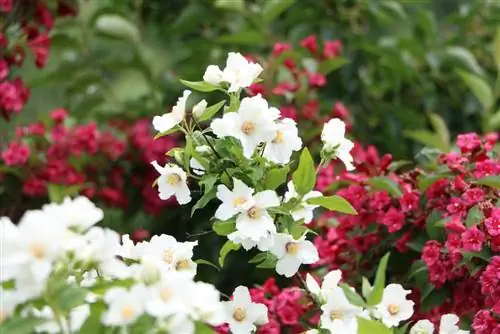
When winter knocks on the garden door, it is time for the jasmine-flowered nightshade to move to frost-free quarters. At the latest when the thermometer consistently falls below 10 degrees, start pruning. The plant tolerates a brief frost of -2 °C without any damage, but is unnecessarily weakened before the already stressful winter. This is what the winter quarters should be like:
- bright and cool at 10 to 12 °C
- the darker the lighting conditions, the colder it can be with a minimum temperature of 5 degrees Celsius
- Under these conditions, leaves and flowers are shed and sprout again in spring
- a warm place in the living room next to a radiator is extremely unsuitable
- Water summer jasmine every now and then and do not fertilize
- check daily for spider mite or lice infestation
The tropical flower beauty will delight you all winter long when it stays in the light-flooded winter garden at 12 to 15 °C. In this case, the water requirement should be adjusted to the higher degree of evaporation. However, the plant does not receive any fertilizer. From the end of February/beginning of March, the potato bush is gradually accustomed to brighter lighting conditions and receives a first dose of diluted liquid fertilizer. Now is the perfect time to repot the plant if the planter is completely rooted.
Conclusion
In its tropical flower splendor, summer jasmine is difficult to outdo as a climbing and hanging plant among native plants. As if the opulent nightshade plant was aware of its decorative value, it demands a feudal level of nursing attention. On hot summer days you will be out with the watering can several times a day because the water requirement is high. The hunger for nutrients that a jasmine-flowered nightshade displays is in no way inferior to this. With the constructive care tips and well-founded instructions for overwintering, the effort required for a potato bush remains within manageable limits.
What you should know about summer jasmine in brief
- The summer jasmine really enhances every garden with its beautiful flowering shape. The large white flowers are very fragrant.
- So the jasmine is not only a feast for the eyes, but also spreads a wonderful scent in the garden.
- The interesting thing is that the scent only develops when the sun has set.
- Summer jasmine is one of the most popular climbing plants. Among other things, because it also grows quite quickly.
- Although jasmine originally comes from the tropics, our jasmine here is hardy.
- The jasmine has now been bred so well that it survives our winters well.
- Jasmine doesn't just cut a fine figure in the garden. It is also very suitable as a container plant.
Care
- Jasmine is unfortunately tempting for aphids. Rarely does a plant remain undamaged.
- Especially when early summer is already very dry.
- If the lice are still in their early stages, normal home remedies, such as spraying dish soap diluted with water onto the plants, are often sufficient.
- However, if the lice infestation is already very advanced, you can get pest control products in special shops.
- It is very important to follow the exact instructions.
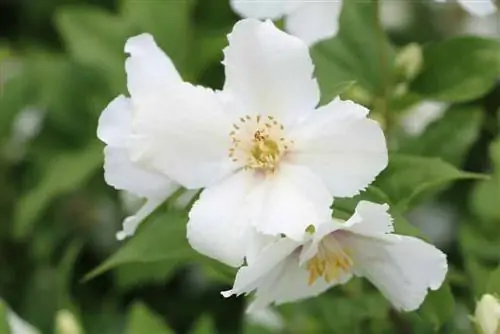
Otherwise, summer jasmine is very easy to care for: the plant thrives best in a nice, sunny location. In order for the plant to thrive, the jasmine should be planted in good, fertile soil. The plant should receive fertilizer once a week. Summer jasmine likes it moist. Therefore, water your plant very well in spring. If the jasmine has finished blooming in autumn, please reduce the amount of water. Because then the plant no longer needs much water until spring. If there is a hard winter, the plant also likes a little lukewarm water.
Wintering
- After the plant has been cut back, you should cover the roots well against frost.
- Leaves or fir branches are ideal for this. Because there are a lot of leaves/fir branches in the garden in autumn.
- If you don't have any leaves available, a linen bag or something similar is also suitable. Just tie it well around the root.
Cutting
- Since the flowering time is in late summer, pruning should only take place in late autumn. This allows the jasmine to fully bloom.
- When cutting, you should make sure that the old shoots remain standing. Cutting too short can cause the plant to die.
- So it's better to be a little more careful when cutting. As a rule of thumb, don't cut below 30 cm from the ground.
- But be careful - do not cut off any shoots from the previous year. Because that's exactly where the next flowers appear.
- It's best to just thin the plant, that's often enough.
- This guarantees that the jasmine will be in full bloom again next year.

